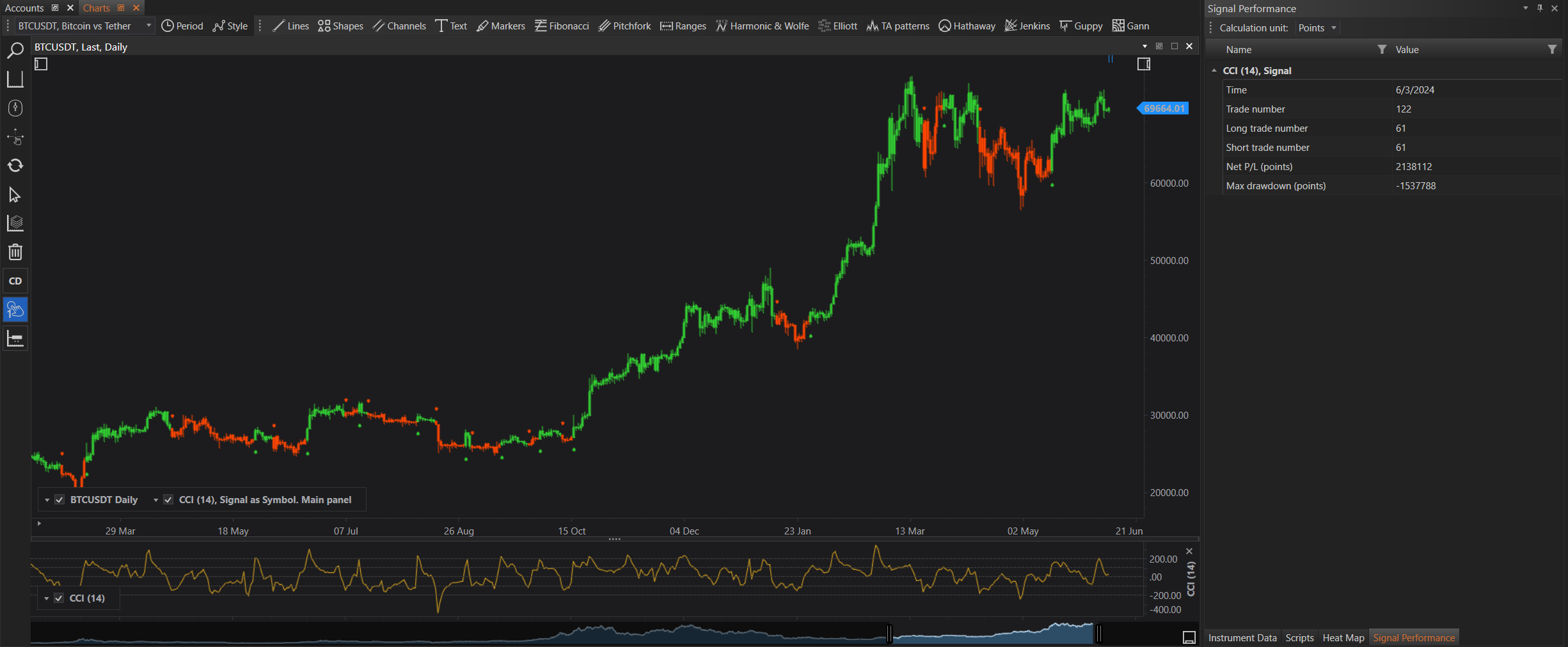- Accounts & Connection Management
- Data Management & Analysis
- Price Monitoring
- Charting
- Trading
- Scanners
-
Builders
-
Manual Strategy Builder
- Main Concept
- Operand Component
- Algo Elements
-
Use Cases
- How to create a condition on something crossing something
- How to create an indicator based on another indicator
- How to calculate a stop loss based on indicator
- How to submit stop order based on calculated price
- How to calculate a current bar price using a price type from inputs
- How to Use a Closed Bar Price
- Automatic Strategy Builder
-
Manual Strategy Builder
- Autotrading
- FinScript
- Trade Analysis
- Media Feeds
- Logs & Notifications
- UI & UX
The Signal Performance Info module integrates with the Charts module and various indicators to evaluate the performance of specific trading signals. This tool is particularly useful for traders who want to test the effectiveness of an indicator or its settings to determine potential profitability.

Overview
Indicators can sometimes appear profitable at first glance, but a detailed analysis of all trades generated by the signals can reveal the true performance. The Signal Performance Info module helps in measuring and recording this performance.
Setting Up
-
Apply Indicator with Signals:
- First, set up the signal on the chosen indicator. This involves configuring the indicator with predefined up and down signals.
- Apply the indicator to the chart.
- First, set up the signal on the chosen indicator. This involves configuring the indicator with predefined up and down signals.
-
Measure Performance:
- Once the indicator with signals is applied, the Signal Performance Info module can be used to measure its performance.
- The module will record and analyze the trades generated by the signals.
- Once the indicator with signals is applied, the Signal Performance Info module can be used to measure its performance.
Features
-
Trade Analysis:
- The module provides a summary of the number of trades generated by the indicator signals.
- It calculates the total points or profits achieved through these trades.
- The module provides a summary of the number of trades generated by the indicator signals.
-
Calculation Units:
- Users can set the calculation unit for performance measurement. The available options are:
- Price
- Points
- Ticks
- Price
- Users can set the calculation unit for performance measurement. The available options are:
Example
In the example provided in the image, the indicator has generated:
- 122 trades
- Total profit of 2,112,121 points
Interface
- The interface shows the details of the indicator, the number of trades, and the performance metrics such as net profit/loss in points and maximum drawdown in points.
- It allows users to select the calculation unit from the available options.
By utilizing the Signal Performance Info module, traders can gain a deeper understanding of the potential effectiveness and profitability of their chosen indicators, helping them make more informed trading decisions.
- Accounts & Connection Management
- Data Management & Analysis
- Price Monitoring
- Charting
- Trading
- Scanners
-
Builders
-
Manual Strategy Builder
- Main Concept
- Operand Component
- Algo Elements
-
Use Cases
- How to create a condition on something crossing something
- How to create an indicator based on another indicator
- How to calculate a stop loss based on indicator
- How to submit stop order based on calculated price
- How to calculate a current bar price using a price type from inputs
- How to Use a Closed Bar Price
- Automatic Strategy Builder
-
Manual Strategy Builder
- Autotrading
- FinScript
- Trade Analysis
- Media Feeds
- Logs & Notifications
- UI & UX